How to address wedding invitations isn’t exactly the sparkle-and-confetti part of planning—but it is one of those little details that people (especially etiquette-loving relatives) will notice. Between juggling seating charts, chasing down RSVPs, and defending your donut wall dreams, the last thing you need is envelope stress. But alas, here we are. Like it or not, etiquette still matters. The good news? I’m here to make it simple, stress-free, and maybe even a little fun.
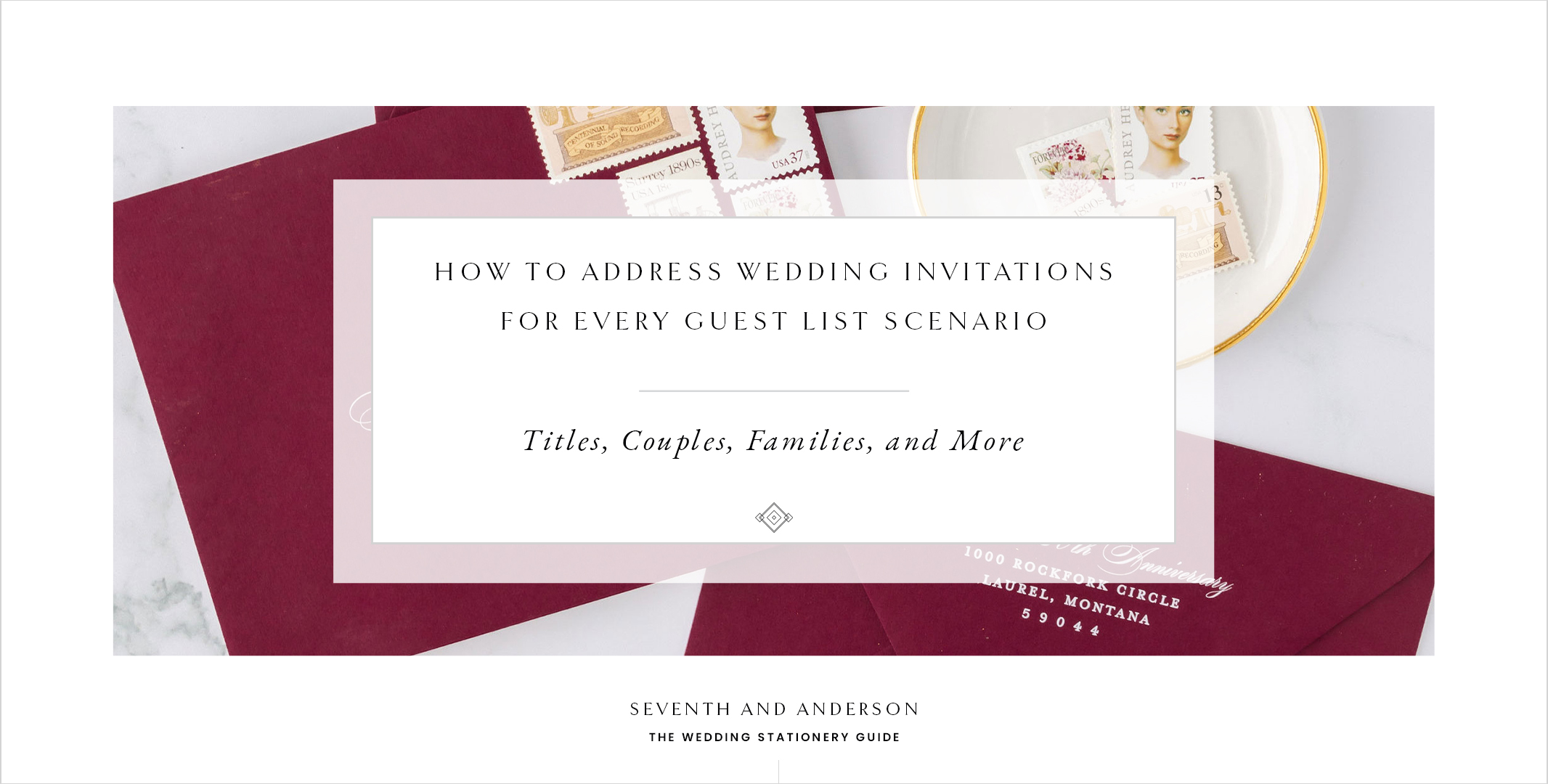
Envelope etiquette in 2025? You have choices. You can channel traditional Emily Post vibes, play it cool, and skip formal titles, or pick and choose like you’re at a wedding-planning buffet.
Spoiler: There’s no single “correct” way anymore. In my world, tradition and modernity happily coexist—and so should your guest list.
The Envelope Dilemma
Single vs. Double and Which One’s Right For You
Before we dive into the nitty-gritty of names and titles, let’s talk envelopes—yes, plural. You might be wondering: Do I really need two? Or even, Wait… what are double envelopes? (You’re not alone—many couples haven’t heard of them.) The answer? It all comes down to your wedding style. Some couples love the timeless tradition of double envelopes, while others are all in on the modern, minimalist vibe. There’s no wrong answer—just what feels right for you and your day.
Single Envelopes: The Modern Way
If you’re all about simplicity, single envelopes are your new best friend. This modern option skips the inner envelope entirely—just one addressed and sealed envelope. It’s clean, eco-friendly, and still perfectly acceptable (yes, even Grandma will survive).
When using single wedding envelopes, your guest addresses are printed on the front, and your return address is printed on the back flap. This option is perfect for weddings with a more casual, contemporary vibe—or if you want to streamline things without sacrificing style.

Double Envelopes: The Traditional Route
Feeling a little fancy? The double envelope is your classic, formal option and is perfect for couples who love those timeless, polished details.
The outer envelope is addressed formally with your return and guest’s addresses. It protects the inner envelope, which holds the invitation and can be a bit more personal—think just first names or nicknames.
Why it’s still a thing (and I recommend them):
- It adds that extra layer of elegance.
- It protects your invitation from wear during the mailing process – especially important if you are using envelope liners or wax seals.
- It gives you a polite and precise way to clarify precisely who’s invited – this is especially helpful regarding families or plus-ones.
- Double envelopes are a great way to incorporate nicknames, only first names, or a more casual tone—perfect for reflecting your relationship with the guest while keeping the outer envelope formal.

How to Address Wedding Invitations for
Married Couples, Same Last Name, Formal
When a couple shares a last name, the most traditional format is “Mr. and Mrs. [His First Name] [Last Name].” It’s formal, classic, and still widely used, especially for more traditional weddings.
INNER ENVELOPES: If you are planning to use double envelopes and want to maintain a formal tone, drop the first names on the inner envelope and write: “Mr. and Mrs. [Last Name].”

How to Address Wedding Invitations for
Married Couples, Same Last Name, Informal
For a more informal option, remove all titles and use first names and their joint last name. Additionally, you don’t have to spell out your guest’s full birth name (i.e., Markus Cardenas vs Mark Cardenas) if they don’t use that name in everyday life.
INNER ENVELOPES: If you are planning to use double envelopes, drop the last name and use first names only, “[First Name] and [First Name].“

How to Address Wedding Invitations for
Married Couples, Different Last Names
If a married couple has different last names, traditional etiquette places the woman’s name first, followed by the man’s. Use both full names, joined by “and,” to indicate they’re married.
DOUBLE ENVELOPE OPTION (FORMAL): If you plan to use double envelopes, drop the first names on the inner envelope and write: “Ms. [Last Name] and Mr. [Last Name].”
DOUBLE ENVELOPE OPTION (INFORMAL): If you plan to use double envelopes, drop the last name and use first names only, “[First Name] and [First Name].“
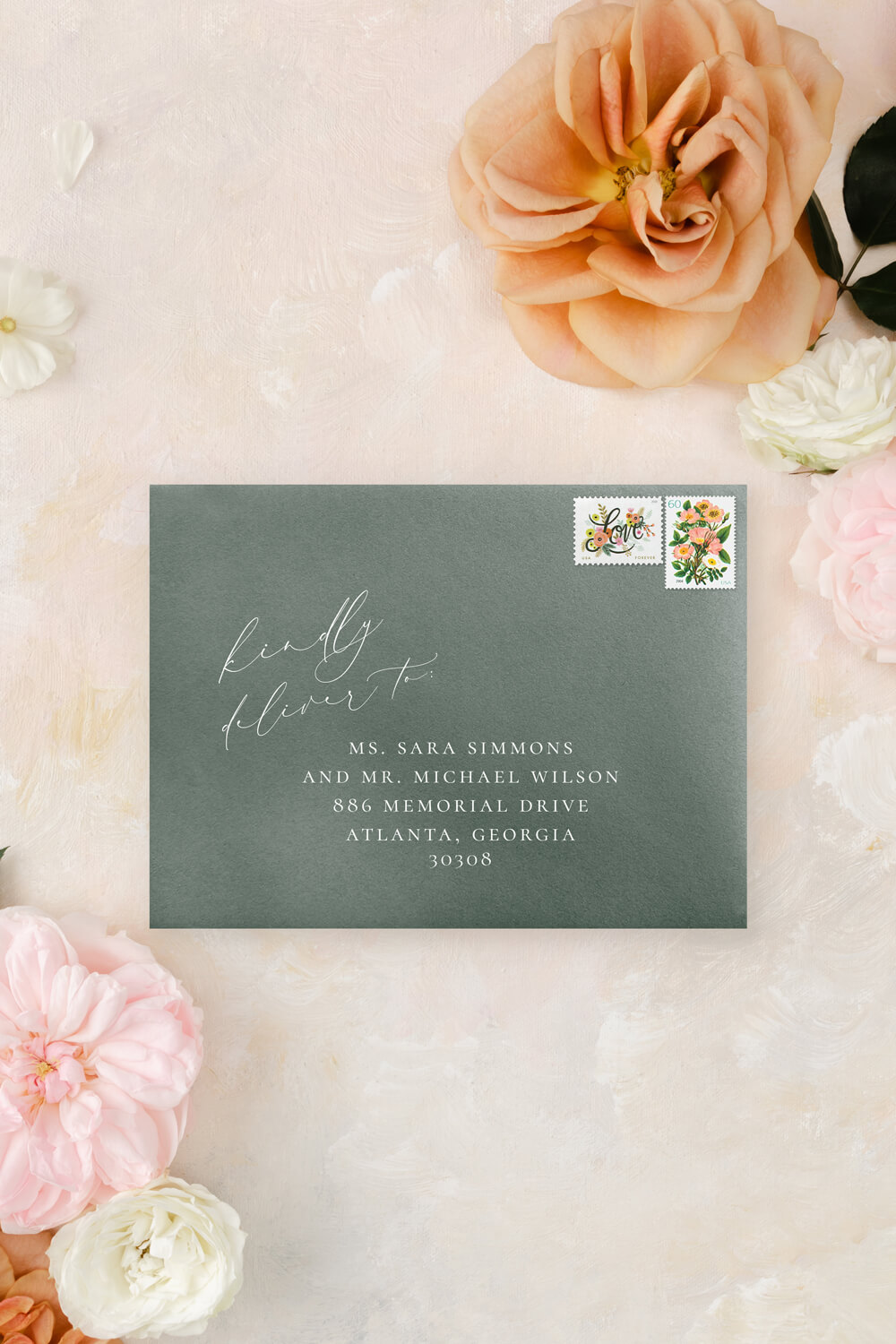
How to Address Wedding Invitations for
Same-Sex Married Couples, Same Last Name
If you are following etiquette to a “T,” same-sex married couples with the same last name are addressed as “Messrs.” or “Mmes.” However, you can also address them just like any other married couple sharing a last name. “Mr. and Mr.” or “Mrs. and Mrs.” to keep things formal, respectful, and straightforward. For a less formal option, omit the prefix.
Who goes first? I recommend placing the names in alphabetical order based on their first name.
DOUBLE ENVELOPE OPTION (FORMAL): If you plan to use double envelopes, drop the first names on the inner envelope and write: “Messrs. or Mmes. [Last Name]”
DOUBLE ENVELOPE OPTION (INFORMAL): If you plan to use double envelopes, drop the last name and use first names only, “[First Name] and [First Name].“

How to Address Wedding Invitations for
Same-Sex Married Couples, Different Last Name
If the same-sex couple is married but has different last names, include their first and last names on the same line, separated by “and.” For more formality, include their desired prefix before their name (Mr. or Ms.).
Who goes first? I recommend placing the names in alphabetical order based on their first name. The key is to be consistent throughout your guest list.
DOUBLE ENVELOPE OPTION (FORMAL): If you plan to use double envelopes, drop the first names on the inner envelope and write: “Ms. or Mr. [Last Name] and Ms. or Mr. [Last Name].”
DOUBLE ENVELOPE OPTION (INFORMAL): If you plan to use double envelopes, drop the last name and use first names only, “[First Name] and [First Name].“

How to Address Wedding Invitations for
Unmarried Couples, Living Together
Unmarried but cohabiting? The etiquette stays the same for everyone: full names, separate lines. It politely signals they live together but haven’t tied the knot.
DOUBLE ENVELOPE OPTION (FORMAL): If you plan to use double envelopes, drop the first names on the inner envelope and write: “Ms. or Mr. [Last Name] on the first line and Ms. or Mr. [Last Name] on the second line.”
DOUBLE ENVELOPE OPTION (INFORMAL): If you plan to use double envelopes, drop the last name and use first names only, “[First Name] on the first line and [First Name] on the second line.”

How to Address Wedding Invitations for
A Single Friend with a Guest
Inviting a single friend with a guest? The best practice is to learn the guest’s name before invitations are mailed and include this on the envelope. However, if that isn’t feasible, or you simply want to give them the option, “And Guest” is the universally understood way to say plus-one. If you’re using double envelopes, save it for the inner envelope to keep the outer one clean and formal. If you’re skipping the inner, include it on the outer. It’s direct, polite, and avoids any awkward guessing games.
SINGLE ENVELOPE OPTION: “Ms. or Mr. [ First Name] [Last Name] and Guest.”
DOUBLE ENVELOPE OPTION (FORMAL): If you use double envelopes, leave “and Guest” OFF the outer envelope and address it to your friend only. On the inner envelope, skip the first names and write: “Ms. [Last Name] and Guest” or “Mr. [Last Name] and Guest.”
DOUBLE ENVELOPE OPTION (INFORMAL): If you use double envelopes, leave “and Guest” OFF the outer envelope and address it to your friend only. On the inner envelope, drop the last name and use first names only, “[First Name] and Guest.”
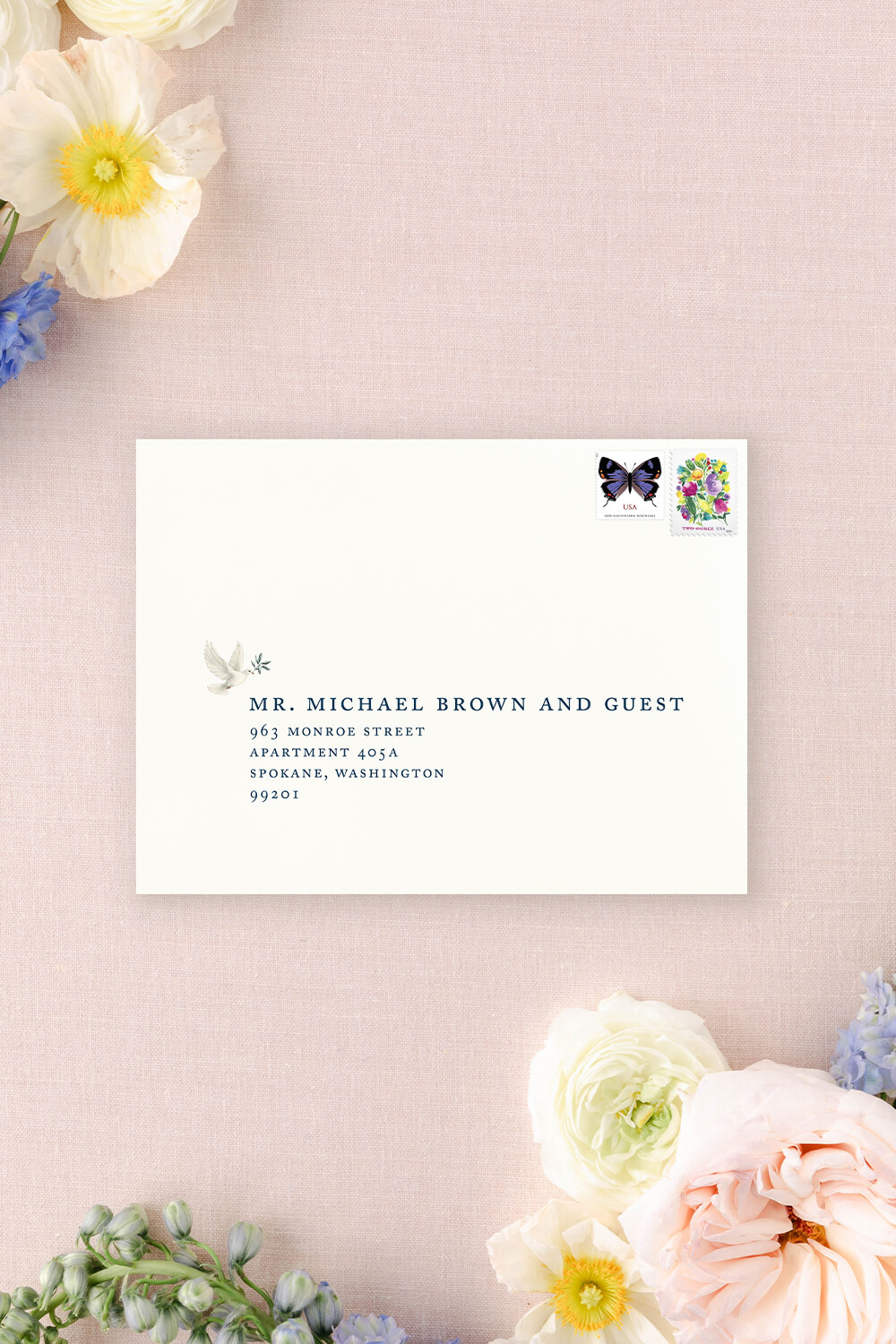
How to Address Wedding Invitations for
Doctors and Medical Professionals
When someone’s earned a title—especially one that took a lot of school—use it. Doctors always get top billing, and if both are doctors, “The Doctors [Last Name]” works perfectly.
For a married male doctor: Address the envelope just as you would for married couples, but use “Dr.” instead of “Mr.” to reflect his professional title.
DOUBLE ENVELOPE OPTION (FORMAL): If using double envelopes, drop the first names on the inner envelope and write: “Dr. and Mrs. [Last Name].”
DOUBLE ENVELOPE OPTION (INFORMAL): If using double envelopes, you can skip titles and last names on the inner envelope—just use first names, “[First Name] and [First Name].“

For a married female doctor: List her name and title first, followed by her spouse’s full name and appropriate title.
DOUBLE ENVELOPE OPTION (FORMAL): If using double envelopes, drop the first names on the inner envelope and write: “Dr. and Mr. [Last Name].”
DOUBLE ENVELOPE OPTION (INFORMAL): If using double envelopes, you can skip titles and last names on the inner envelope—just use first names, “Her [First Name] and Spouse [First Name].“

If both are doctors with the same last name, address the envelope to “The Doctors [Last Name].”
DOUBLE ENVELOPE OPTION (FORMAL): If using double envelopes, write “Drs. [Last Name].”
DOUBLE ENVELOPE OPTION (INFORMAL): If using double envelopes, you can skip titles and last names on the inner envelope—use first names, “[First Name] and [First Name].“

How to Address Wedding Invitations for
Active Duty Military Personnel
CALLOUT: Commissioned vs. Enlisted: Key differences when addressing your wedding invitations
There’s a key difference in military etiquette: Only commissioned officers (think Captain, Lieutenant, Major) should have their rank included on the envelope. Enlisted members (like Sergeants or Corporals) are generally addressed just like civilians—no rank necessary unless you know they prefer it.
Military rank always comes first—literally and figuratively. Always use the entire rank and branch of service when addressing envelopes. The inner envelope can be more relaxed, but respect for service is key.
DOUBLE ENVELOPE OPTION (FORMAL): If using double envelopes, write “[Rank] [Last Name].”
DOUBLE ENVELOPE OPTION (INFORMAL): If using double envelopes, you can skip titles and last names on the inner envelope—use first names, “[First Name].“
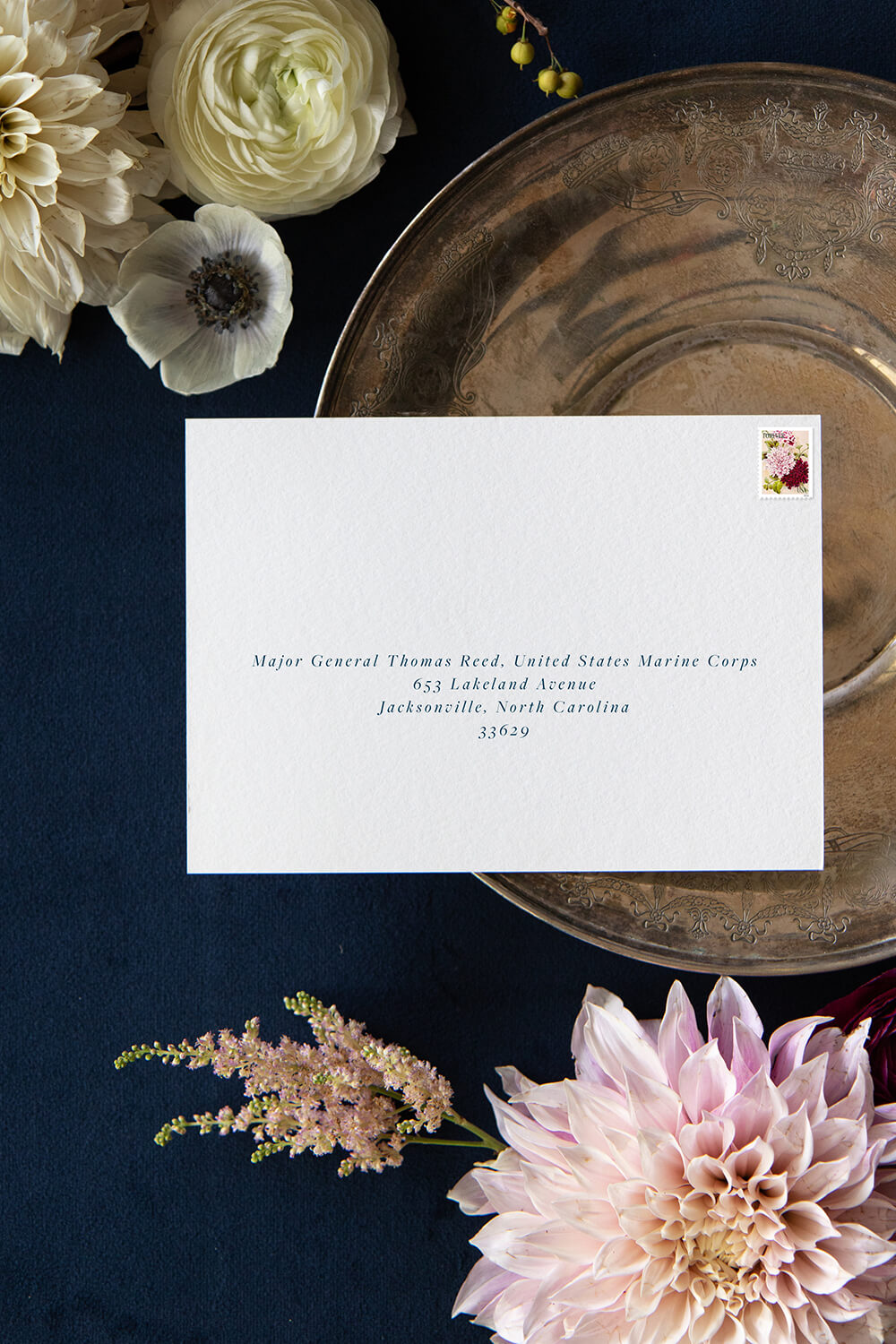
How to Address Wedding Invitations for
A Married Military Couple, Only One in Service
When one spouse is in the military, list their full title and branch first, followed by their spouse’s name and appropriate title. This honors the service member’s rank while still including both individuals properly. ***Due to the size constraints of envelopes, you can list the service member and their spouse on separate lines, if necessary. Just make sure to include “and” between their names to indicate they are married.
DOUBLE ENVELOPE OPTION (FORMAL): If using double envelopes, write “[Rank] [Last Name] and Mr. or Mrs. [Last Name].“
DOUBLE ENVELOPE OPTION (INFORMAL): If using double envelopes, you can skip titles and last names on the inner envelope—use first names, “[First Name] and [First Name].“

How to Address Wedding Invitations for
A Married Military Couple, Both in Service, Same Branch
If both spouses are serving in the same branch of the military, list them by rank, in order of seniority.
DOUBLE ENVELOPE OPTION (FORMAL): If using double envelopes, write “[Rank] and [Rank] [Last Name].”
DOUBLE ENVELOPE OPTION (INFORMAL): If using double envelopes, you can skip titles and last names on the inner envelope—use first names, “[First Name] and [First Name].“
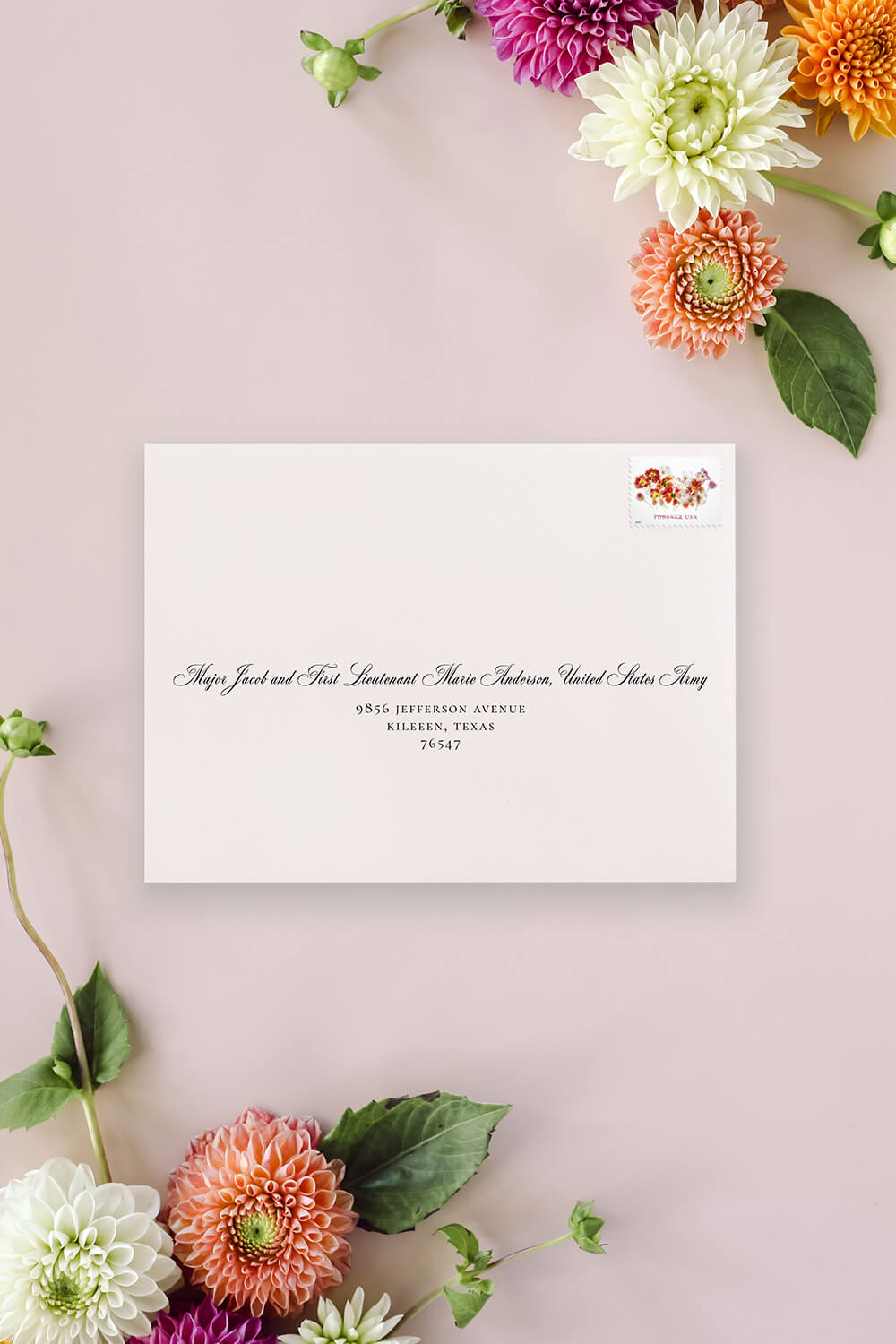
How to Address Wedding Invitations for
A Married Military Couple, Both in Service, Different Branches
If both spouses are in the military but serve in different branches, list them by rank, in order of seniority, and on two separate lines with “and” added to the beginning of the second line to indicate that the couple is married.
DOUBLE ENVELOPE OPTION (FORMAL): If using double envelopes, write “[Rank] [Last Name] and [Rank] [Last Name].”
DOUBLE ENVELOPE OPTION (INFORMAL): If using double envelopes, you can skip titles and last names on the inner envelope—use first names, “[First Name] and [First Name].“

How to Address Wedding Invitations for
Retired Military Personnel
For retired military members, include their former rank and branch, followed by “Retired” or “Ret.” This is an important distinction that recognizes their service while noting their current status.
NOTE: It’s always a good idea to check with your guest directly. Some retired military members prefer to forgo their titles entirely, while others appreciate having them included.
DOUBLE ENVELOPE OPTION (FORMAL): If using double envelopes, you can write “[Rank] [Last Name]” or simply use “Mr., Ms., or Mrs. [Last Name].”
DOUBLE ENVELOPE OPTION (INFORMAL): If using double envelopes, you can skip titles and last names on the inner envelope—use first names, “[First Name].“

How to Address Wedding Invitations for
People with Official Titles (Judge, Reverend, etc.)
Use professional or official titles for anyone who holds one. Think “The Honorable” for judges, “Reverend” for clergy, and so on. It’s a sign of respect and adds a layer of formality.
DOUBLE ENVELOPE OPTION (FORMAL): If using double envelopes, list “[Official Title] [Last Name].” If they are married, address their spouse as follows with “and” to indicate marriage, “Mr. or Mrs. [Last Name].”
DOUBLE ENVELOPE OPTION (INFORMAL): If using double envelopes, you can skip titles and last names on the inner envelope—use first names, “[First Name] and [First Name].“

How to Address Wedding Invitations for Families
Single Envelopes, Children Invited
If you’re using a single (outer) envelope and inviting the whole family, the best approach is to address it to “The [Last Name] Family.” This indicates that the entire household, including children, are invited to the wedding and reception.
Alternative: If you want to be more specific, you can list the parents’ full names, followed by “and Family.” “Mr. and Mrs. [Last Name] and Family.“
Blended Families: Not all families look the same—and your envelopes shouldn’t assume they do! When parents or children have different last names, it’s worth taking extra care to make your invitation feel thoughtful and inclusive. For simplicity, using a format like “Mr. and Mrs. [Last Name] and Family” signals that everyone in the household is invited. And if you’re tight on space or unsure about the wording, always prioritize clarity over tradition.
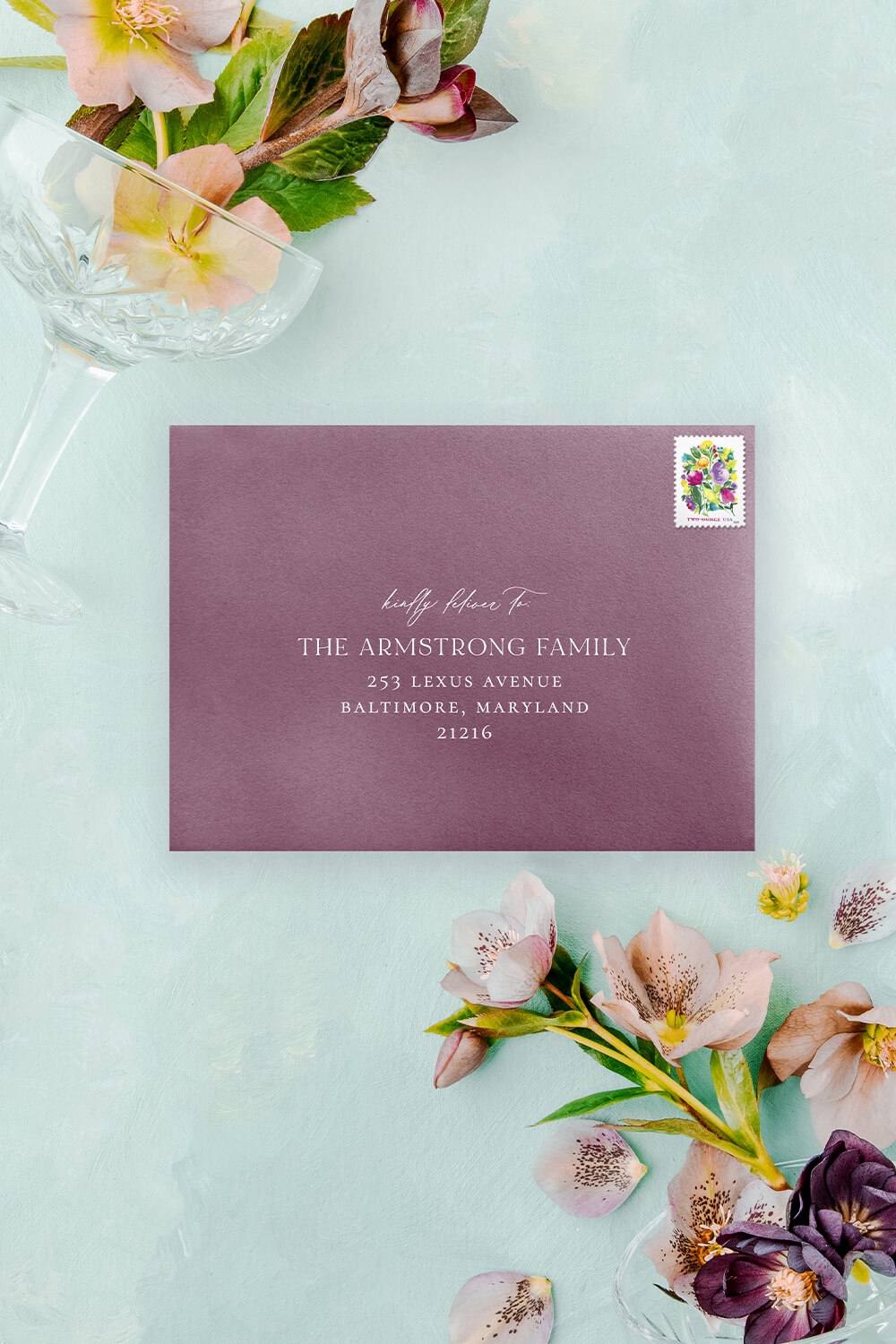
How to Address Wedding Invitations for Families
Single Envelopes, Children Not Invited
When you’re only inviting the adults in the household and using a single envelope, address it strictly to the parents. Do not include “and Family” or any reference to children. Use a standard couple format like Mr. and Mrs. [First Name] [Last Name]. Reference any of the above examples for guidance.
This subtly, but clearly, indicates that the invitation is for adults only. No extra notes are needed—unless you’re expecting confusion, in which case a polite conversation may help.
How to Address Wedding Invitations for Families
Double Envelopes, Children Invited
When using double envelopes, the outer envelope stays formal and is typically addressed to the parents only. The inner envelope is where you can personally list each invited family member, including the children. This makes it crystal clear who’s invited, without needing to spell it out elsewhere.
OUTER ENVELOPE (TRADITIONAL): Address the outer envelope to the parents only. “Mr. and Mrs. [His First Name] [Last Name].”
OUTER ENVELOPE (ALTERNATIVE): If you’d like to hint that children are invited from the start, you can address the outer envelope to “The [Last Name] Family” or “Mr. and Mrs. [His First Name] [Last Name] and Family.“
INNER ENVELOPE (FORMAL): List the parents on the first line on the inner envelope, then each child on their own line below. For example, on line one: “Mr. and Mrs. [Last Name],” line two: the child’s full name, “[First Name] [Last Name],” and line three: child’s full name, “[First Name] [Last Name]” and so on.
INNER ENVELOPE (INFORMAL): On the inner envelope, you can skip titles and last names on the inner envelope—use first names. For example, on line one, list the parents’ first names, “[First Name] and [First Name],” and then on line two, list the children’s names, “[First Name], [First Name], and [First Name].”

How to Address Wedding Invitations for Families
Double Envelopes, Children Not Invited
You can reinforce that the invitation is adults-only by listing only the parents on the outer and inner envelopes. The envelope addressing format is the same as for a couple without children. Reference any of the above examples for guidance.
Using only the parents’ names makes it clear that the kids are not on the guest list without having to spell it out.
How to Address Wedding Invitations for
A Guest Who Goes By Their Middle Name
Some people prefer to go by their middle name—and that’s completely fine! For the outer envelope, use their first initial followed by their middle and last name to keep things formal but accurate. Feel free to use their preferred name on the inner envelope for a more personal touch.
DOUBLE ENVELOPE OPTION (FORMAL): If using double envelopes, list “Mr. or Ms. [Last Name].”
DOUBLE ENVELOPE OPTION (INFORMAL): If using double envelopes, you can skip titles and last names on the inner envelope and use their preferred name, “[Preferred Name].”

How to Address Your Wedding Invitations
Some Final Thoughts
Here are a few essential etiquette tips I’d like to highlight.
- Spell out full titles and names—avoid abbreviations except for “Mr.,” “Mrs.,” and “Ms.”
- Spell out street names, states, and apartment or unit designations.
- Use professional titles (e.g., Doctor, Captain) on the outer envelope when applicable.
- For inner envelopes, you can take a more relaxed approach, omit titles, and use nicknames if you prefer.
I’m not an official etiquette expert, but after designing 500+ invitation suites, I have seen my fair share of envelopes come and go. So while these tips are based on real-life wedding experiences, lots of happy couples, and more “Mr.” vs. “Dr.” debates than I can count, if you’re looking for the official rulebook, head over to Emily Post’s website—they’re the true pros when it comes to tradition.
If you have any questions or need extra guidance, don’t hesitate to reach out—I’m here to help! Just email me directly at janeil@seventhandanderson.com or message me via my Contact Page, and I’ll be back in your inbox with a response in no time.
Not sure how many invitations to actually order? Check out this post where I break it all down—because, trust me, it’s fewer than your guest count but more than you think.
Looking for inspiration? Explore my Portfolio to see how past couples have transformed their vision into beautifully crafted invitations.
comments +